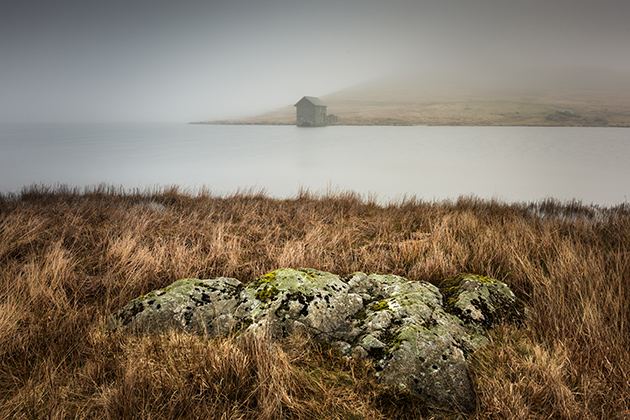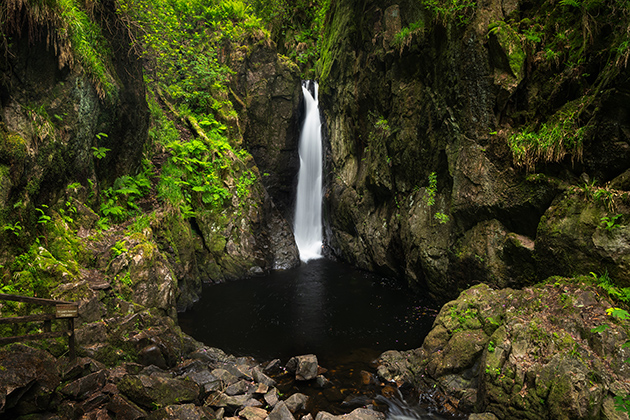The Lake District is full of spectacular locations, though for sheer ruggedness and remoteness the Eskdale Valley takes some beating. Alfred Wainwright described Eskdale as ‘One of the loveliest of Lakeland’s valleys, descends from the highest and wildest mountains in the district to the sands of Ravenglass in a swift transition from bleak and craggy ridges, to verdant woodlands and pastures watered by a charming river.’
The valley is notable for being one of few major valleys in the Lake District not to have its own lake, although several tarns are perched above the valley sides including Devoke Water, which is the largest tarn in the Lake District.
Located on the edge of the National Park, the valley is linked to its perhaps more illustrious neighbour, the Langdale Valley, by the infamous Hardknott and Wrynose Pass. It’s also home to the highest ground in England, the Scafells, as well as other 850m-plus peaks like Bowfell, Esk Pike and Crinkle Crags. The south-east facing aspect of the Scafells is probably an even more spectacular vista than its more commonly seen view from the ever-popular Wastwater.
The valley has a multitude of places you can photograph, including the ancient Roman Fort, Stanley Ghyll waterfall, the many streams along the River Esk as they wind their way up to the head of the valley, Devoke Water on the nearby Birker Fell, and the dramatic views across to the Scafell Range from Hardknott Fell itself.

The misty conditions at Devoke Water create a great atmospheric shot. Nikon D810, 16-35mm, 25sec at f/13, ISO 40. Credit: Stuart McGlennon
How to shoot Eskdale
When to visit Eskdale
Autumn would absolutely be my choice for the best time of year to visit, where the foliage is turning to more vibrant colours, and the sunrise/sunset times are more amenable. In late autumn the light in the evening floods the valley and lights up the distant fells, and there’s even the possibility of some snow on the high peaks if you time it well. Additionally, locations like Stanley Ghyll and the surrounding woodland areas are likely to be full of colour.
Eskdale pubs, campsites and B&Bs
The valley offers several pubs and B&Bs along its road out towards Eskdale Green – probably the best one is the Woolpack Inn which serves delicious food year round and also has accommodation. Also the Bower House Inn at Eskdale Green is worth a look. There are two or three campsites dotted along the valley for those wanting to camp.
What to avoid
If visiting in winter, check local traffic updates as during cold snaps the Hardknott Pass and Birker Fell roads are often closed due to the threat of ice, or if there’s been a heavy snowfall. These roads in good conditions are fine to drive through but should be avoided in ice, though often the decision is taken for you anyway by the authorities. Make sure that if you take to the high fells to always be prepared, with suitable warm clothing for the conditions, maps/compasses, etc. and also to inform someone of your intended route. The weather can quickly change in the Lakes so always be as best prepared as you can be.

An isolated waterfall surrounded by rich green vegetation makes a great shot with a slow shutter speed. Fujifilm X-T3 with 16-55mm lens, 1sec at f/8, ISO 160. Credit: Stuart McGlennon
Photography Kit list
- Telephoto zoom The weather in the Lakes is often extremely changeable, which makes for some wonderful displays of dappled light on the tops of the high peaks, so a good telephoto to pick out and isolate those moments is essential.
- ND filters & polariser The many streams and waterfalls offer great opportunities to experiment with longer shutter speeds, making an ND filter a vital bit of kit as well as a polariser to kill the glare and saturate the colours on those wet rocks.
Stuart McGlennon is a professional landscape photographer and gallery owner based in the Lake District. He won the Sunday Times Magazine Award in this year’s UK Landscape Photographer Of The Year.







